7312MED Epidemiology: Smoking, Housing, and Health Report Analysis
VerifiedAdded on 2022/09/08
|11
|3343
|15
Report
AI Summary
This report analyzes a quasi-experimental, longitudinal study conducted in Glasgow, UK, investigating the relationship between housing improvements and smoking cessation in deprived areas. The study compared a housing improvement (HI) group with a non-HI group, adjusting for baseline sociodemographic factors and smoking habits. Key research questions focused on whether HI influenced smoking cessation and if any effects were mediated by improved mental health. The findings indicated no direct correlation between HI and decreased smoking rates; however, a significant association was found between HI and the intention to quit smoking, which persisted after adjustments. The study also explored potential biases, including information bias, and compared the findings with previous research, such as Blackman's and West & Sohal's works, to understand the complexities of behavioral change. The report concludes by suggesting the importance of integrating health services with housing regeneration projects to support positive behavioral changes and address the social determinants of health.

Running head: Question and Answers
Question and Answers
Name of the student
Name of the university
Author’s name
Question and Answers
Name of the student
Name of the university
Author’s name
Paraphrase This Document
Need a fresh take? Get an instant paraphrase of this document with our AI Paraphraser

Question and Answers
1.
It is a Quasi-experimental and a 2 year-longitudinal study conducted with the aim to
examine the relationship between smoking and the intention of quitting it with housing
improvements due to an improved mental health. Quasi-experimental studies are useful in
determining the association of an intervention with that of an outcome through experiments
where the intervention strategies are not assigned randomly. These studies are generally used for
evaluating rapid responses against any outbreaks or other issues related to patient safety hat
requires rapid interventions that are non-randomised. Quasi-experimental studies are classified
into three classes including designs with control groups, disturbed time series designs, and
designs without control groups. Two key features of Quasi-experimental study are:
These studies are not as much of expensive and require less resources when compared to
that of the RCT (Randomized Controlled Trials or Cluster Randomized Trails. Quasi-
Experimental studies are generally executed at the population level instead of individual level
and therefore, they incorporate patients as the sample population who are excluded from RCTs
like those people who feel ill for giving informed consent or patients undergoing serious
treatments (Schweizer, Braun & Milstone, 2016).
Quasi-experimental studies gives more realistic and conclusive findings since they assess
and determine the practical efficiency of an intervention developed and implemented by
healthcare workforce, rather than evaluating only the efficacy of an intervention employed by the
research staff under the provided controlled research conditions. Thus, these studies are
considered to be more generalized and hold more legitimacy than RCTs (Schweizer, Braun &
Milstone, 2016).
2.
As per the study, the research questions are as follows:
Is there any connection between housing improvements and the intention of quit smoking? If
yes, can this be explained on the grounds of mental health developments in stress following to
housing improvements?
1.
It is a Quasi-experimental and a 2 year-longitudinal study conducted with the aim to
examine the relationship between smoking and the intention of quitting it with housing
improvements due to an improved mental health. Quasi-experimental studies are useful in
determining the association of an intervention with that of an outcome through experiments
where the intervention strategies are not assigned randomly. These studies are generally used for
evaluating rapid responses against any outbreaks or other issues related to patient safety hat
requires rapid interventions that are non-randomised. Quasi-experimental studies are classified
into three classes including designs with control groups, disturbed time series designs, and
designs without control groups. Two key features of Quasi-experimental study are:
These studies are not as much of expensive and require less resources when compared to
that of the RCT (Randomized Controlled Trials or Cluster Randomized Trails. Quasi-
Experimental studies are generally executed at the population level instead of individual level
and therefore, they incorporate patients as the sample population who are excluded from RCTs
like those people who feel ill for giving informed consent or patients undergoing serious
treatments (Schweizer, Braun & Milstone, 2016).
Quasi-experimental studies gives more realistic and conclusive findings since they assess
and determine the practical efficiency of an intervention developed and implemented by
healthcare workforce, rather than evaluating only the efficacy of an intervention employed by the
research staff under the provided controlled research conditions. Thus, these studies are
considered to be more generalized and hold more legitimacy than RCTs (Schweizer, Braun &
Milstone, 2016).
2.
As per the study, the research questions are as follows:
Is there any connection between housing improvements and the intention of quit smoking? If
yes, can this be explained on the grounds of mental health developments in stress following to
housing improvements?
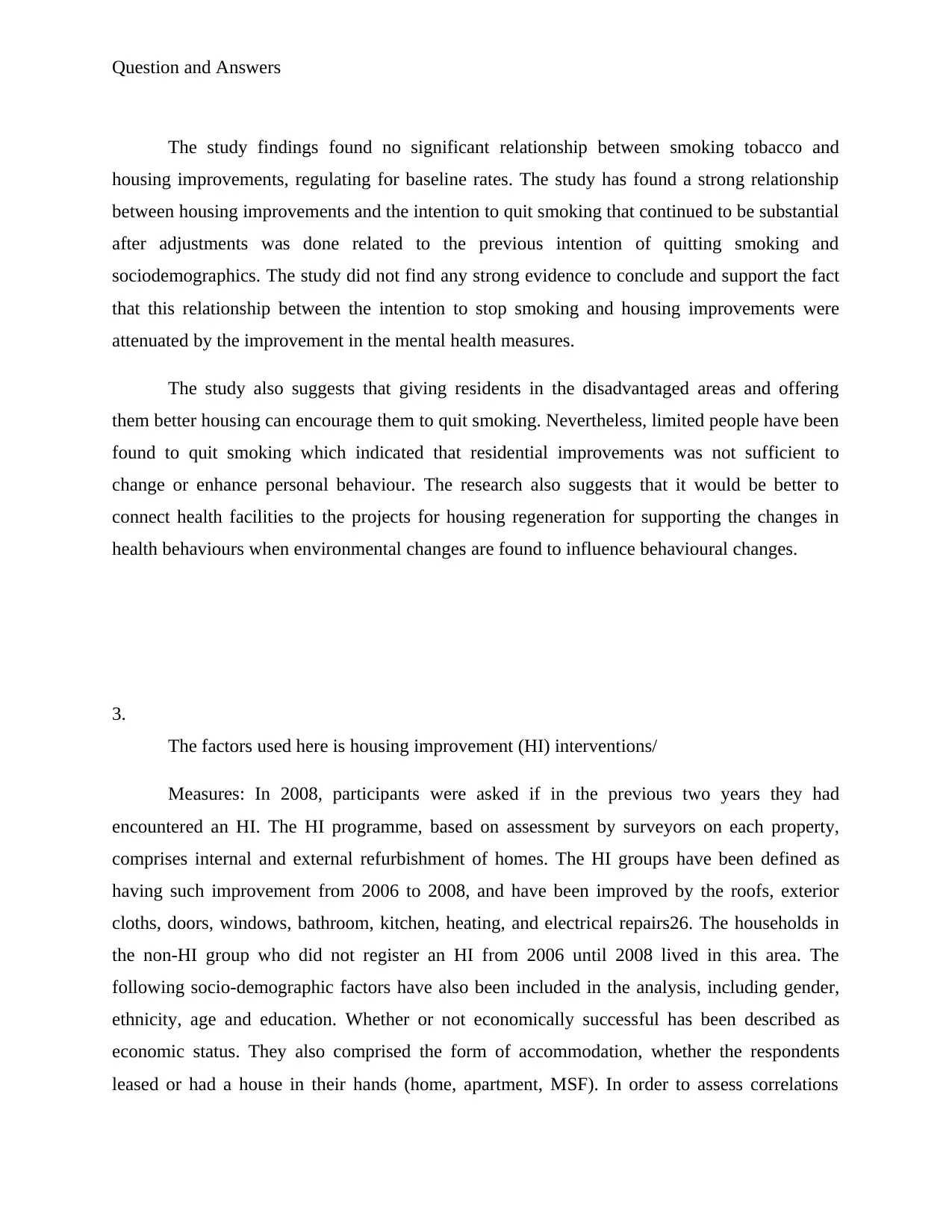
Question and Answers
The study findings found no significant relationship between smoking tobacco and
housing improvements, regulating for baseline rates. The study has found a strong relationship
between housing improvements and the intention to quit smoking that continued to be substantial
after adjustments was done related to the previous intention of quitting smoking and
sociodemographics. The study did not find any strong evidence to conclude and support the fact
that this relationship between the intention to stop smoking and housing improvements were
attenuated by the improvement in the mental health measures.
The study also suggests that giving residents in the disadvantaged areas and offering
them better housing can encourage them to quit smoking. Nevertheless, limited people have been
found to quit smoking which indicated that residential improvements was not sufficient to
change or enhance personal behaviour. The research also suggests that it would be better to
connect health facilities to the projects for housing regeneration for supporting the changes in
health behaviours when environmental changes are found to influence behavioural changes.
3.
The factors used here is housing improvement (HI) interventions/
Measures: In 2008, participants were asked if in the previous two years they had
encountered an HI. The HI programme, based on assessment by surveyors on each property,
comprises internal and external refurbishment of homes. The HI groups have been defined as
having such improvement from 2006 to 2008, and have been improved by the roofs, exterior
cloths, doors, windows, bathroom, kitchen, heating, and electrical repairs26. The households in
the non-HI group who did not register an HI from 2006 until 2008 lived in this area. The
following socio-demographic factors have also been included in the analysis, including gender,
ethnicity, age and education. Whether or not economically successful has been described as
economic status. They also comprised the form of accommodation, whether the respondents
leased or had a house in their hands (home, apartment, MSF). In order to assess correlations
The study findings found no significant relationship between smoking tobacco and
housing improvements, regulating for baseline rates. The study has found a strong relationship
between housing improvements and the intention to quit smoking that continued to be substantial
after adjustments was done related to the previous intention of quitting smoking and
sociodemographics. The study did not find any strong evidence to conclude and support the fact
that this relationship between the intention to stop smoking and housing improvements were
attenuated by the improvement in the mental health measures.
The study also suggests that giving residents in the disadvantaged areas and offering
them better housing can encourage them to quit smoking. Nevertheless, limited people have been
found to quit smoking which indicated that residential improvements was not sufficient to
change or enhance personal behaviour. The research also suggests that it would be better to
connect health facilities to the projects for housing regeneration for supporting the changes in
health behaviours when environmental changes are found to influence behavioural changes.
3.
The factors used here is housing improvement (HI) interventions/
Measures: In 2008, participants were asked if in the previous two years they had
encountered an HI. The HI programme, based on assessment by surveyors on each property,
comprises internal and external refurbishment of homes. The HI groups have been defined as
having such improvement from 2006 to 2008, and have been improved by the roofs, exterior
cloths, doors, windows, bathroom, kitchen, heating, and electrical repairs26. The households in
the non-HI group who did not register an HI from 2006 until 2008 lived in this area. The
following socio-demographic factors have also been included in the analysis, including gender,
ethnicity, age and education. Whether or not economically successful has been described as
economic status. They also comprised the form of accommodation, whether the respondents
leased or had a house in their hands (home, apartment, MSF). In order to assess correlations
⊘ This is a preview!⊘
Do you want full access?
Subscribe today to unlock all pages.

Trusted by 1+ million students worldwide
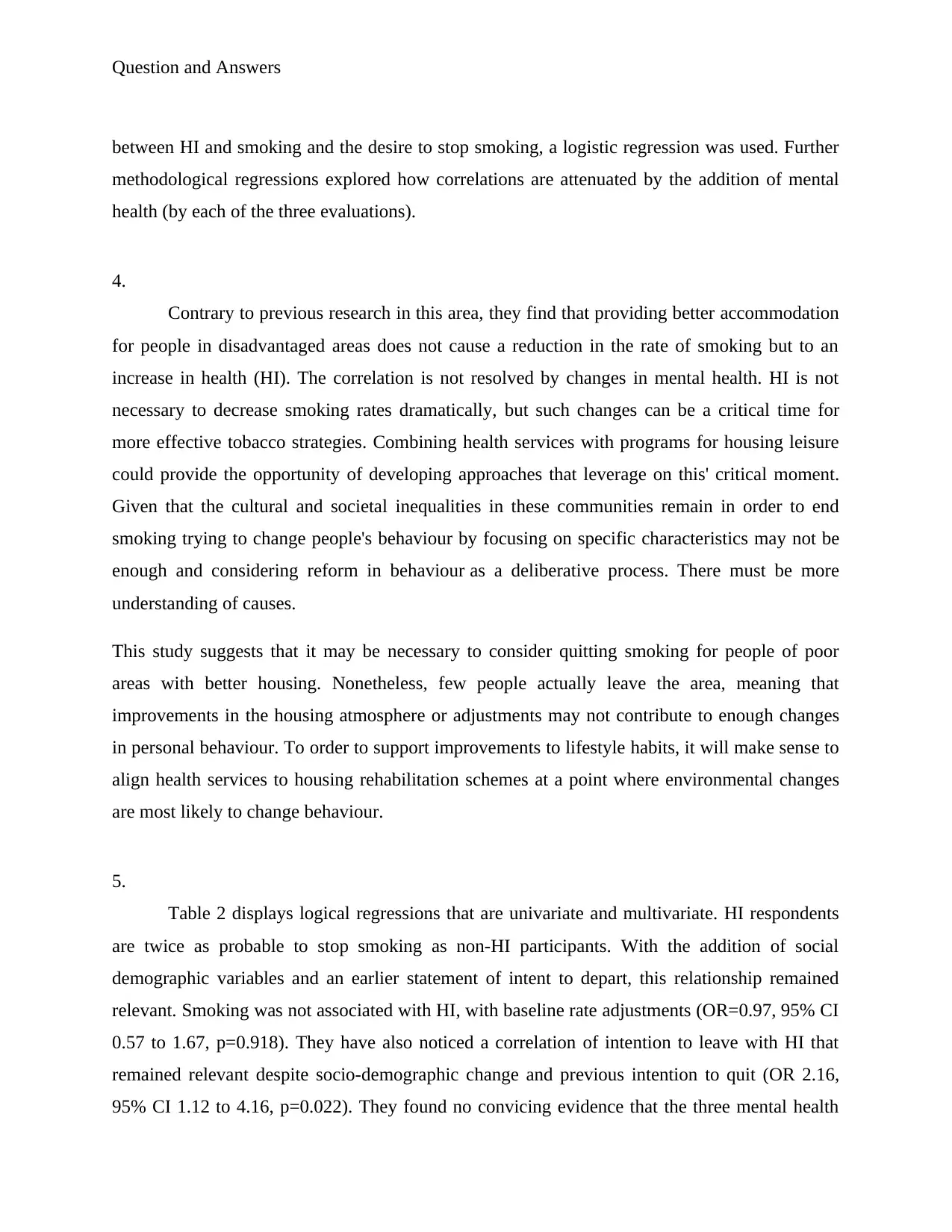
Question and Answers
between HI and smoking and the desire to stop smoking, a logistic regression was used. Further
methodological regressions explored how correlations are attenuated by the addition of mental
health (by each of the three evaluations).
4.
Contrary to previous research in this area, they find that providing better accommodation
for people in disadvantaged areas does not cause a reduction in the rate of smoking but to an
increase in health (HI). The correlation is not resolved by changes in mental health. HI is not
necessary to decrease smoking rates dramatically, but such changes can be a critical time for
more effective tobacco strategies. Combining health services with programs for housing leisure
could provide the opportunity of developing approaches that leverage on this' critical moment.
Given that the cultural and societal inequalities in these communities remain in order to end
smoking trying to change people's behaviour by focusing on specific characteristics may not be
enough and considering reform in behaviour as a deliberative process. There must be more
understanding of causes.
This study suggests that it may be necessary to consider quitting smoking for people of poor
areas with better housing. Nonetheless, few people actually leave the area, meaning that
improvements in the housing atmosphere or adjustments may not contribute to enough changes
in personal behaviour. To order to support improvements to lifestyle habits, it will make sense to
align health services to housing rehabilitation schemes at a point where environmental changes
are most likely to change behaviour.
5.
Table 2 displays logical regressions that are univariate and multivariate. HI respondents
are twice as probable to stop smoking as non-HI participants. With the addition of social
demographic variables and an earlier statement of intent to depart, this relationship remained
relevant. Smoking was not associated with HI, with baseline rate adjustments (OR=0.97, 95% CI
0.57 to 1.67, p=0.918). They have also noticed a correlation of intention to leave with HI that
remained relevant despite socio-demographic change and previous intention to quit (OR 2.16,
95% CI 1.12 to 4.16, p=0.022). They found no convicing evidence that the three mental health
between HI and smoking and the desire to stop smoking, a logistic regression was used. Further
methodological regressions explored how correlations are attenuated by the addition of mental
health (by each of the three evaluations).
4.
Contrary to previous research in this area, they find that providing better accommodation
for people in disadvantaged areas does not cause a reduction in the rate of smoking but to an
increase in health (HI). The correlation is not resolved by changes in mental health. HI is not
necessary to decrease smoking rates dramatically, but such changes can be a critical time for
more effective tobacco strategies. Combining health services with programs for housing leisure
could provide the opportunity of developing approaches that leverage on this' critical moment.
Given that the cultural and societal inequalities in these communities remain in order to end
smoking trying to change people's behaviour by focusing on specific characteristics may not be
enough and considering reform in behaviour as a deliberative process. There must be more
understanding of causes.
This study suggests that it may be necessary to consider quitting smoking for people of poor
areas with better housing. Nonetheless, few people actually leave the area, meaning that
improvements in the housing atmosphere or adjustments may not contribute to enough changes
in personal behaviour. To order to support improvements to lifestyle habits, it will make sense to
align health services to housing rehabilitation schemes at a point where environmental changes
are most likely to change behaviour.
5.
Table 2 displays logical regressions that are univariate and multivariate. HI respondents
are twice as probable to stop smoking as non-HI participants. With the addition of social
demographic variables and an earlier statement of intent to depart, this relationship remained
relevant. Smoking was not associated with HI, with baseline rate adjustments (OR=0.97, 95% CI
0.57 to 1.67, p=0.918). They have also noticed a correlation of intention to leave with HI that
remained relevant despite socio-demographic change and previous intention to quit (OR 2.16,
95% CI 1.12 to 4.16, p=0.022). They found no convicing evidence that the three mental health
Paraphrase This Document
Need a fresh take? Get an instant paraphrase of this document with our AI Paraphraser
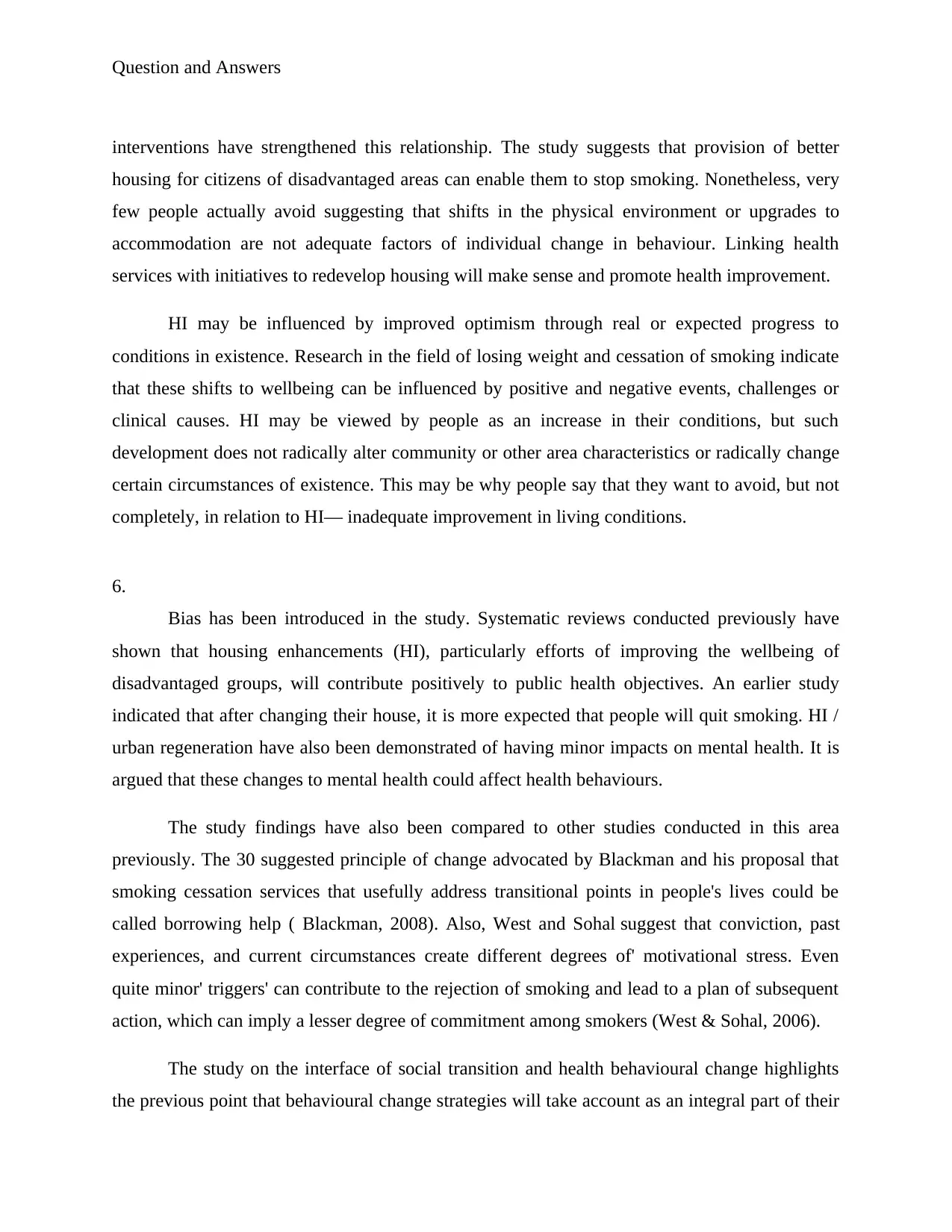
Question and Answers
interventions have strengthened this relationship. The study suggests that provision of better
housing for citizens of disadvantaged areas can enable them to stop smoking. Nonetheless, very
few people actually avoid suggesting that shifts in the physical environment or upgrades to
accommodation are not adequate factors of individual change in behaviour. Linking health
services with initiatives to redevelop housing will make sense and promote health improvement.
HI may be influenced by improved optimism through real or expected progress to
conditions in existence. Research in the field of losing weight and cessation of smoking indicate
that these shifts to wellbeing can be influenced by positive and negative events, challenges or
clinical causes. HI may be viewed by people as an increase in their conditions, but such
development does not radically alter community or other area characteristics or radically change
certain circumstances of existence. This may be why people say that they want to avoid, but not
completely, in relation to HI— inadequate improvement in living conditions.
6.
Bias has been introduced in the study. Systematic reviews conducted previously have
shown that housing enhancements (HI), particularly efforts of improving the wellbeing of
disadvantaged groups, will contribute positively to public health objectives. An earlier study
indicated that after changing their house, it is more expected that people will quit smoking. HI /
urban regeneration have also been demonstrated of having minor impacts on mental health. It is
argued that these changes to mental health could affect health behaviours.
The study findings have also been compared to other studies conducted in this area
previously. The 30 suggested principle of change advocated by Blackman and his proposal that
smoking cessation services that usefully address transitional points in people's lives could be
called borrowing help ( Blackman, 2008). Also, West and Sohal suggest that conviction, past
experiences, and current circumstances create different degrees of' motivational stress. Even
quite minor' triggers' can contribute to the rejection of smoking and lead to a plan of subsequent
action, which can imply a lesser degree of commitment among smokers (West & Sohal, 2006).
The study on the interface of social transition and health behavioural change highlights
the previous point that behavioural change strategies will take account as an integral part of their
interventions have strengthened this relationship. The study suggests that provision of better
housing for citizens of disadvantaged areas can enable them to stop smoking. Nonetheless, very
few people actually avoid suggesting that shifts in the physical environment or upgrades to
accommodation are not adequate factors of individual change in behaviour. Linking health
services with initiatives to redevelop housing will make sense and promote health improvement.
HI may be influenced by improved optimism through real or expected progress to
conditions in existence. Research in the field of losing weight and cessation of smoking indicate
that these shifts to wellbeing can be influenced by positive and negative events, challenges or
clinical causes. HI may be viewed by people as an increase in their conditions, but such
development does not radically alter community or other area characteristics or radically change
certain circumstances of existence. This may be why people say that they want to avoid, but not
completely, in relation to HI— inadequate improvement in living conditions.
6.
Bias has been introduced in the study. Systematic reviews conducted previously have
shown that housing enhancements (HI), particularly efforts of improving the wellbeing of
disadvantaged groups, will contribute positively to public health objectives. An earlier study
indicated that after changing their house, it is more expected that people will quit smoking. HI /
urban regeneration have also been demonstrated of having minor impacts on mental health. It is
argued that these changes to mental health could affect health behaviours.
The study findings have also been compared to other studies conducted in this area
previously. The 30 suggested principle of change advocated by Blackman and his proposal that
smoking cessation services that usefully address transitional points in people's lives could be
called borrowing help ( Blackman, 2008). Also, West and Sohal suggest that conviction, past
experiences, and current circumstances create different degrees of' motivational stress. Even
quite minor' triggers' can contribute to the rejection of smoking and lead to a plan of subsequent
action, which can imply a lesser degree of commitment among smokers (West & Sohal, 2006).
The study on the interface of social transition and health behavioural change highlights
the previous point that behavioural change strategies will take account as an integral part of their

Question and Answers
individualistic or cognitive adjustment interpretation of environmental and situational influences.
While the study found no decline in smoking rates for people with an HI, it observed that
discrepancies between HI and non-HI groups in terms of their willingness to quit smoking are
much more likely to occur. However, the discrepancies in the desire to leave were not clarified
by fundamental differences.
7.
Information bias occurs when any data used in a study is either inaccurately measured or
recorded. Knowledge bias like all other types of bias tends to lead to wrong results or outcomes
that deliberately vary from the facts. In fact, three types of preference can occur in observational
studies: selection, confounding and information bias. Randomized trials may also involve
selection distortions and information bias. In this study, records from two intersectional surveys
are linked and therefore have implications for sample representativeness and potential selection
biases. This limitation is present in this study for both groups (i.e. we have internal validity),
however their results are generalizable. They also have changes in the time scales they have been
talking about regarding mental health initiatives. For the last four weeks, the SF-12MH has been
talking about the other two steps over the last 12 months. There were quite little routinely
recorded mental illnesses, and there were very small numbers of changes that reduced the
reliability of the impact estimation.
8.
The Blackman research, on the one side, recorded 5-year persistence and perhaps more
time needed for smoking to be detected, although this analysis does not assume this is possible.
On the contrary, it was a smaller study and thus limited in its capacity to adapt to confusing
people and the cluster nature of their information was not taken into account: 98 households, 209
respondents. They have also reported that their study is larger and the sample is broader and
involves a larger proportion of individuals who are more probable to smoke and less likely to
stop under relatively poor circumstances.
individualistic or cognitive adjustment interpretation of environmental and situational influences.
While the study found no decline in smoking rates for people with an HI, it observed that
discrepancies between HI and non-HI groups in terms of their willingness to quit smoking are
much more likely to occur. However, the discrepancies in the desire to leave were not clarified
by fundamental differences.
7.
Information bias occurs when any data used in a study is either inaccurately measured or
recorded. Knowledge bias like all other types of bias tends to lead to wrong results or outcomes
that deliberately vary from the facts. In fact, three types of preference can occur in observational
studies: selection, confounding and information bias. Randomized trials may also involve
selection distortions and information bias. In this study, records from two intersectional surveys
are linked and therefore have implications for sample representativeness and potential selection
biases. This limitation is present in this study for both groups (i.e. we have internal validity),
however their results are generalizable. They also have changes in the time scales they have been
talking about regarding mental health initiatives. For the last four weeks, the SF-12MH has been
talking about the other two steps over the last 12 months. There were quite little routinely
recorded mental illnesses, and there were very small numbers of changes that reduced the
reliability of the impact estimation.
8.
The Blackman research, on the one side, recorded 5-year persistence and perhaps more
time needed for smoking to be detected, although this analysis does not assume this is possible.
On the contrary, it was a smaller study and thus limited in its capacity to adapt to confusing
people and the cluster nature of their information was not taken into account: 98 households, 209
respondents. They have also reported that their study is larger and the sample is broader and
involves a larger proportion of individuals who are more probable to smoke and less likely to
stop under relatively poor circumstances.
⊘ This is a preview!⊘
Do you want full access?
Subscribe today to unlock all pages.

Trusted by 1+ million students worldwide

Question and Answers
The potential confounders that have been identified by the authors are previous studies
conducted in this area. Systematic reviews indicated the ability for housing improvement (HI)
programs to support the welfare of disadvantaged groups and improve their health. A previous
study indicated that after changes to their households people are more likely to stop smoking. It
has also been shown that HI / urban regeneration has small impacts on mental health and that
these changes in mental health may affect medical behaviour.
According to the authors, his study is based on quasi-experimental design, the
longitudinal data on a relative sample and the ability to adjust to potential basic confounders.
This permits them take causal pathways and mechanisms into account. In terms of the intention
to quit, the comparison (2006) between the two groups showed a small but not significant
difference.
A substantially more number of people in the HI group, however, have stated that they
are planning to leave the non-HI group in 2008 (52% vs36% respectively); the intention to quit
the non-HI group has dropped substantially (−23%) but has dropped only marginally (−3%).
Table 2 displays logistic regressions that are standardized and multivariate. HI members were
twice as likely as the non-HI sample to quit smoking, which was important when the socio-
demographic factors are included and a previous statement of intention to quit remains
significant.
9.
Yes, the authors have responded to the second research question through the help of the
table 3 results. The authors concentrated on the interaction between HI, mental health and the
willingness to quit smoking in order to address the second question. It is because prior analyzes
revealed little correlation between active smoking and getting a HI (tweaking to past smoking
status), but found a connection between the desire to quit smoking and a HI and a link between
better mental health and HI. To analyze how mental health changes, reduce the connection
between HI and the intent to quit smoking, Table 3 provides four parametric analyses results in
the correlation between HI and the decision to stop smoking and the three mental health tests. All
designs are adapted to socio-demographic factors and also adapted to the corresponding health
The potential confounders that have been identified by the authors are previous studies
conducted in this area. Systematic reviews indicated the ability for housing improvement (HI)
programs to support the welfare of disadvantaged groups and improve their health. A previous
study indicated that after changes to their households people are more likely to stop smoking. It
has also been shown that HI / urban regeneration has small impacts on mental health and that
these changes in mental health may affect medical behaviour.
According to the authors, his study is based on quasi-experimental design, the
longitudinal data on a relative sample and the ability to adjust to potential basic confounders.
This permits them take causal pathways and mechanisms into account. In terms of the intention
to quit, the comparison (2006) between the two groups showed a small but not significant
difference.
A substantially more number of people in the HI group, however, have stated that they
are planning to leave the non-HI group in 2008 (52% vs36% respectively); the intention to quit
the non-HI group has dropped substantially (−23%) but has dropped only marginally (−3%).
Table 2 displays logistic regressions that are standardized and multivariate. HI members were
twice as likely as the non-HI sample to quit smoking, which was important when the socio-
demographic factors are included and a previous statement of intention to quit remains
significant.
9.
Yes, the authors have responded to the second research question through the help of the
table 3 results. The authors concentrated on the interaction between HI, mental health and the
willingness to quit smoking in order to address the second question. It is because prior analyzes
revealed little correlation between active smoking and getting a HI (tweaking to past smoking
status), but found a connection between the desire to quit smoking and a HI and a link between
better mental health and HI. To analyze how mental health changes, reduce the connection
between HI and the intent to quit smoking, Table 3 provides four parametric analyses results in
the correlation between HI and the decision to stop smoking and the three mental health tests. All
designs are adapted to socio-demographic factors and also adapted to the corresponding health
Paraphrase This Document
Need a fresh take? Get an instant paraphrase of this document with our AI Paraphraser
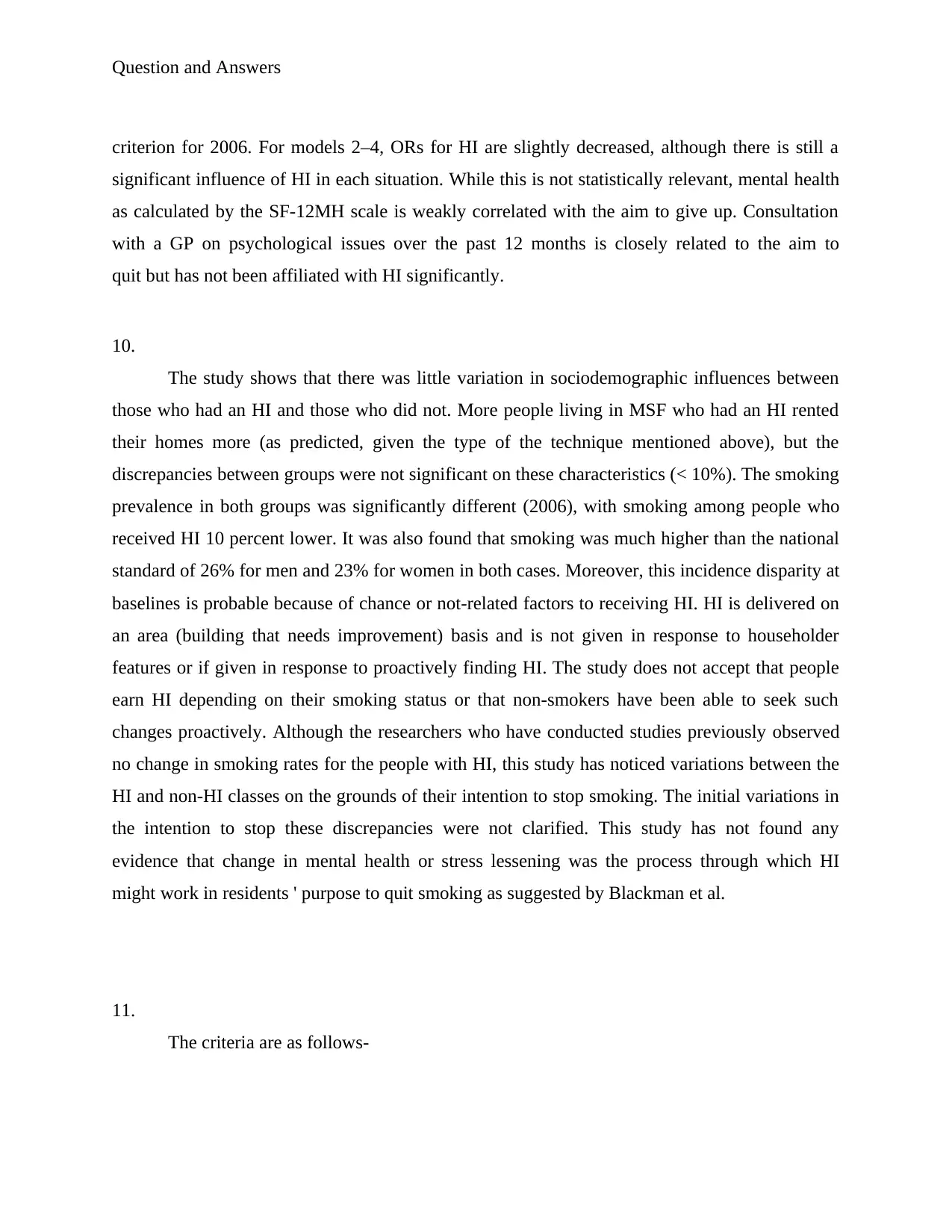
Question and Answers
criterion for 2006. For models 2–4, ORs for HI are slightly decreased, although there is still a
significant influence of HI in each situation. While this is not statistically relevant, mental health
as calculated by the SF-12MH scale is weakly correlated with the aim to give up. Consultation
with a GP on psychological issues over the past 12 months is closely related to the aim to
quit but has not been affiliated with HI significantly.
10.
The study shows that there was little variation in sociodemographic influences between
those who had an HI and those who did not. More people living in MSF who had an HI rented
their homes more (as predicted, given the type of the technique mentioned above), but the
discrepancies between groups were not significant on these characteristics (< 10%). The smoking
prevalence in both groups was significantly different (2006), with smoking among people who
received HI 10 percent lower. It was also found that smoking was much higher than the national
standard of 26% for men and 23% for women in both cases. Moreover, this incidence disparity at
baselines is probable because of chance or not-related factors to receiving HI. HI is delivered on
an area (building that needs improvement) basis and is not given in response to householder
features or if given in response to proactively finding HI. The study does not accept that people
earn HI depending on their smoking status or that non-smokers have been able to seek such
changes proactively. Although the researchers who have conducted studies previously observed
no change in smoking rates for the people with HI, this study has noticed variations between the
HI and non-HI classes on the grounds of their intention to stop smoking. The initial variations in
the intention to stop these discrepancies were not clarified. This study has not found any
evidence that change in mental health or stress lessening was the process through which HI
might work in residents ' purpose to quit smoking as suggested by Blackman et al.
11.
The criteria are as follows-
criterion for 2006. For models 2–4, ORs for HI are slightly decreased, although there is still a
significant influence of HI in each situation. While this is not statistically relevant, mental health
as calculated by the SF-12MH scale is weakly correlated with the aim to give up. Consultation
with a GP on psychological issues over the past 12 months is closely related to the aim to
quit but has not been affiliated with HI significantly.
10.
The study shows that there was little variation in sociodemographic influences between
those who had an HI and those who did not. More people living in MSF who had an HI rented
their homes more (as predicted, given the type of the technique mentioned above), but the
discrepancies between groups were not significant on these characteristics (< 10%). The smoking
prevalence in both groups was significantly different (2006), with smoking among people who
received HI 10 percent lower. It was also found that smoking was much higher than the national
standard of 26% for men and 23% for women in both cases. Moreover, this incidence disparity at
baselines is probable because of chance or not-related factors to receiving HI. HI is delivered on
an area (building that needs improvement) basis and is not given in response to householder
features or if given in response to proactively finding HI. The study does not accept that people
earn HI depending on their smoking status or that non-smokers have been able to seek such
changes proactively. Although the researchers who have conducted studies previously observed
no change in smoking rates for the people with HI, this study has noticed variations between the
HI and non-HI classes on the grounds of their intention to stop smoking. The initial variations in
the intention to stop these discrepancies were not clarified. This study has not found any
evidence that change in mental health or stress lessening was the process through which HI
might work in residents ' purpose to quit smoking as suggested by Blackman et al.
11.
The criteria are as follows-
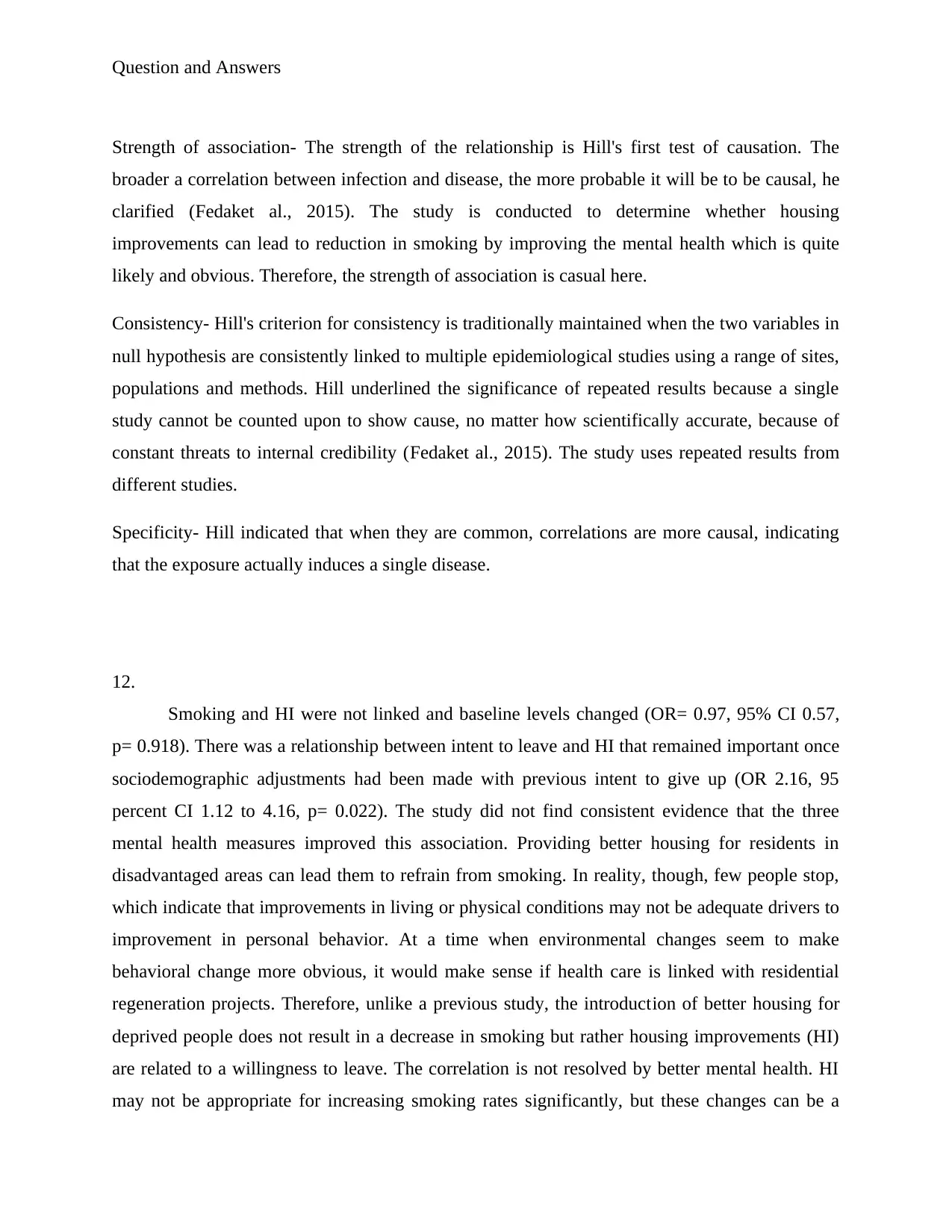
Question and Answers
Strength of association- The strength of the relationship is Hill's first test of causation. The
broader a correlation between infection and disease, the more probable it will be to be causal, he
clarified (Fedaket al., 2015). The study is conducted to determine whether housing
improvements can lead to reduction in smoking by improving the mental health which is quite
likely and obvious. Therefore, the strength of association is casual here.
Consistency- Hill's criterion for consistency is traditionally maintained when the two variables in
null hypothesis are consistently linked to multiple epidemiological studies using a range of sites,
populations and methods. Hill underlined the significance of repeated results because a single
study cannot be counted upon to show cause, no matter how scientifically accurate, because of
constant threats to internal credibility (Fedaket al., 2015). The study uses repeated results from
different studies.
Specificity- Hill indicated that when they are common, correlations are more causal, indicating
that the exposure actually induces a single disease.
12.
Smoking and HI were not linked and baseline levels changed (OR= 0.97, 95% CI 0.57,
p= 0.918). There was a relationship between intent to leave and HI that remained important once
sociodemographic adjustments had been made with previous intent to give up (OR 2.16, 95
percent CI 1.12 to 4.16, p= 0.022). The study did not find consistent evidence that the three
mental health measures improved this association. Providing better housing for residents in
disadvantaged areas can lead them to refrain from smoking. In reality, though, few people stop,
which indicate that improvements in living or physical conditions may not be adequate drivers to
improvement in personal behavior. At a time when environmental changes seem to make
behavioral change more obvious, it would make sense if health care is linked with residential
regeneration projects. Therefore, unlike a previous study, the introduction of better housing for
deprived people does not result in a decrease in smoking but rather housing improvements (HI)
are related to a willingness to leave. The correlation is not resolved by better mental health. HI
may not be appropriate for increasing smoking rates significantly, but these changes can be a
Strength of association- The strength of the relationship is Hill's first test of causation. The
broader a correlation between infection and disease, the more probable it will be to be causal, he
clarified (Fedaket al., 2015). The study is conducted to determine whether housing
improvements can lead to reduction in smoking by improving the mental health which is quite
likely and obvious. Therefore, the strength of association is casual here.
Consistency- Hill's criterion for consistency is traditionally maintained when the two variables in
null hypothesis are consistently linked to multiple epidemiological studies using a range of sites,
populations and methods. Hill underlined the significance of repeated results because a single
study cannot be counted upon to show cause, no matter how scientifically accurate, because of
constant threats to internal credibility (Fedaket al., 2015). The study uses repeated results from
different studies.
Specificity- Hill indicated that when they are common, correlations are more causal, indicating
that the exposure actually induces a single disease.
12.
Smoking and HI were not linked and baseline levels changed (OR= 0.97, 95% CI 0.57,
p= 0.918). There was a relationship between intent to leave and HI that remained important once
sociodemographic adjustments had been made with previous intent to give up (OR 2.16, 95
percent CI 1.12 to 4.16, p= 0.022). The study did not find consistent evidence that the three
mental health measures improved this association. Providing better housing for residents in
disadvantaged areas can lead them to refrain from smoking. In reality, though, few people stop,
which indicate that improvements in living or physical conditions may not be adequate drivers to
improvement in personal behavior. At a time when environmental changes seem to make
behavioral change more obvious, it would make sense if health care is linked with residential
regeneration projects. Therefore, unlike a previous study, the introduction of better housing for
deprived people does not result in a decrease in smoking but rather housing improvements (HI)
are related to a willingness to leave. The correlation is not resolved by better mental health. HI
may not be appropriate for increasing smoking rates significantly, but these changes can be a
⊘ This is a preview!⊘
Do you want full access?
Subscribe today to unlock all pages.

Trusted by 1+ million students worldwide

Question and Answers
critical time for focused smoking operations. Connecting health services with housing
rehabilitation projects may provide the potential for developing acts to capitalize on this' critical
moment. However, the generalizability is limited in the study (Bond et al., 2013).
critical time for focused smoking operations. Connecting health services with housing
rehabilitation projects may provide the potential for developing acts to capitalize on this' critical
moment. However, the generalizability is limited in the study (Bond et al., 2013).
Paraphrase This Document
Need a fresh take? Get an instant paraphrase of this document with our AI Paraphraser
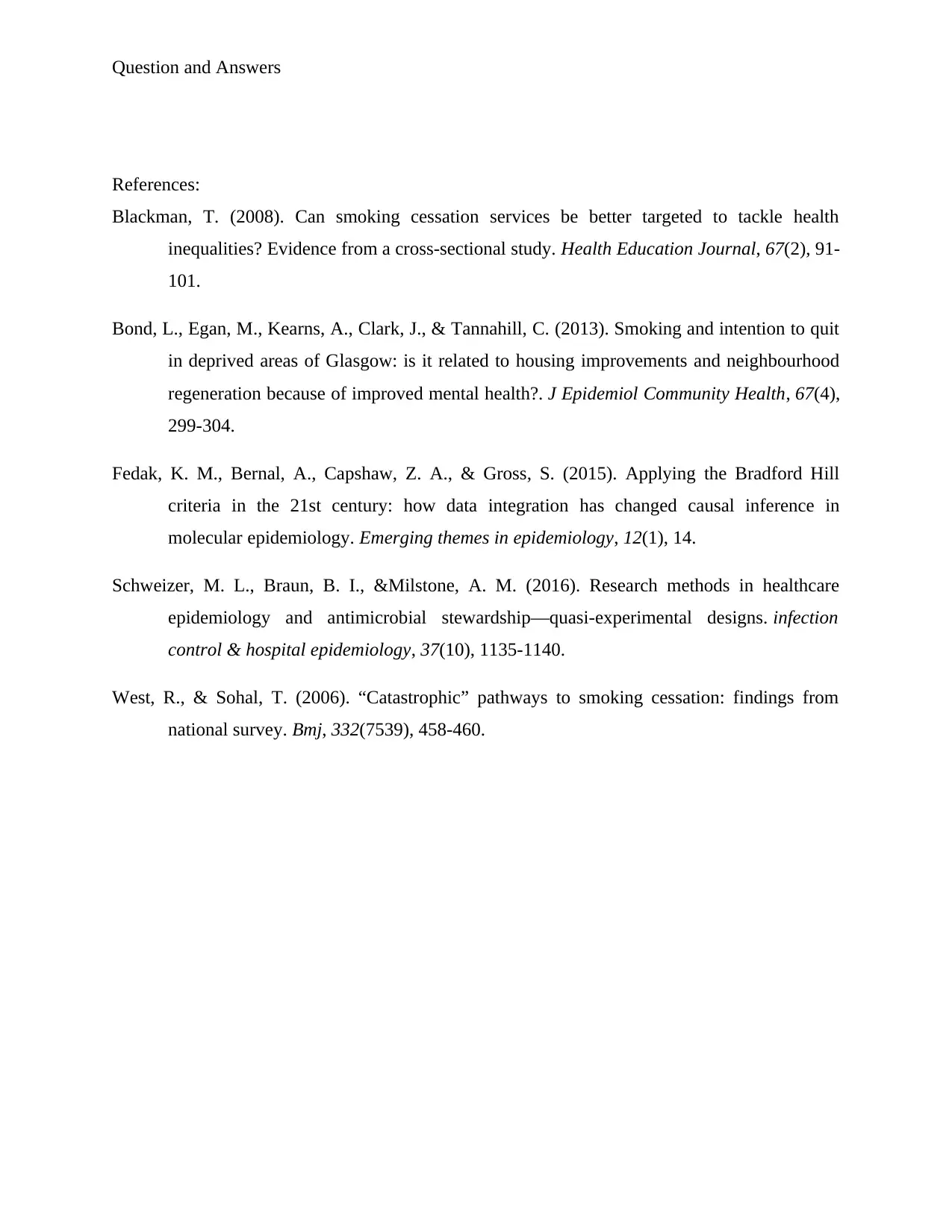
Question and Answers
References:
Blackman, T. (2008). Can smoking cessation services be better targeted to tackle health
inequalities? Evidence from a cross-sectional study. Health Education Journal, 67(2), 91-
101.
Bond, L., Egan, M., Kearns, A., Clark, J., & Tannahill, C. (2013). Smoking and intention to quit
in deprived areas of Glasgow: is it related to housing improvements and neighbourhood
regeneration because of improved mental health?. J Epidemiol Community Health, 67(4),
299-304.
Fedak, K. M., Bernal, A., Capshaw, Z. A., & Gross, S. (2015). Applying the Bradford Hill
criteria in the 21st century: how data integration has changed causal inference in
molecular epidemiology. Emerging themes in epidemiology, 12(1), 14.
Schweizer, M. L., Braun, B. I., &Milstone, A. M. (2016). Research methods in healthcare
epidemiology and antimicrobial stewardship—quasi-experimental designs. infection
control & hospital epidemiology, 37(10), 1135-1140.
West, R., & Sohal, T. (2006). “Catastrophic” pathways to smoking cessation: findings from
national survey. Bmj, 332(7539), 458-460.
References:
Blackman, T. (2008). Can smoking cessation services be better targeted to tackle health
inequalities? Evidence from a cross-sectional study. Health Education Journal, 67(2), 91-
101.
Bond, L., Egan, M., Kearns, A., Clark, J., & Tannahill, C. (2013). Smoking and intention to quit
in deprived areas of Glasgow: is it related to housing improvements and neighbourhood
regeneration because of improved mental health?. J Epidemiol Community Health, 67(4),
299-304.
Fedak, K. M., Bernal, A., Capshaw, Z. A., & Gross, S. (2015). Applying the Bradford Hill
criteria in the 21st century: how data integration has changed causal inference in
molecular epidemiology. Emerging themes in epidemiology, 12(1), 14.
Schweizer, M. L., Braun, B. I., &Milstone, A. M. (2016). Research methods in healthcare
epidemiology and antimicrobial stewardship—quasi-experimental designs. infection
control & hospital epidemiology, 37(10), 1135-1140.
West, R., & Sohal, T. (2006). “Catastrophic” pathways to smoking cessation: findings from
national survey. Bmj, 332(7539), 458-460.
1 out of 11
Related Documents
Your All-in-One AI-Powered Toolkit for Academic Success.
+13062052269
info@desklib.com
Available 24*7 on WhatsApp / Email
![[object Object]](/_next/static/media/star-bottom.7253800d.svg)
Unlock your academic potential
Copyright © 2020–2025 A2Z Services. All Rights Reserved. Developed and managed by ZUCOL.





